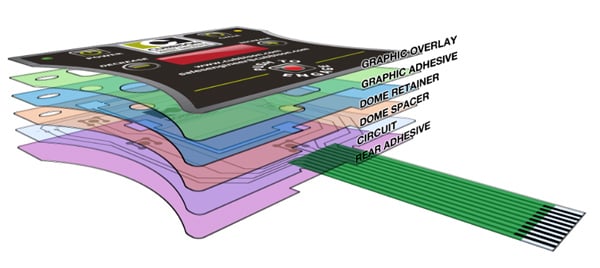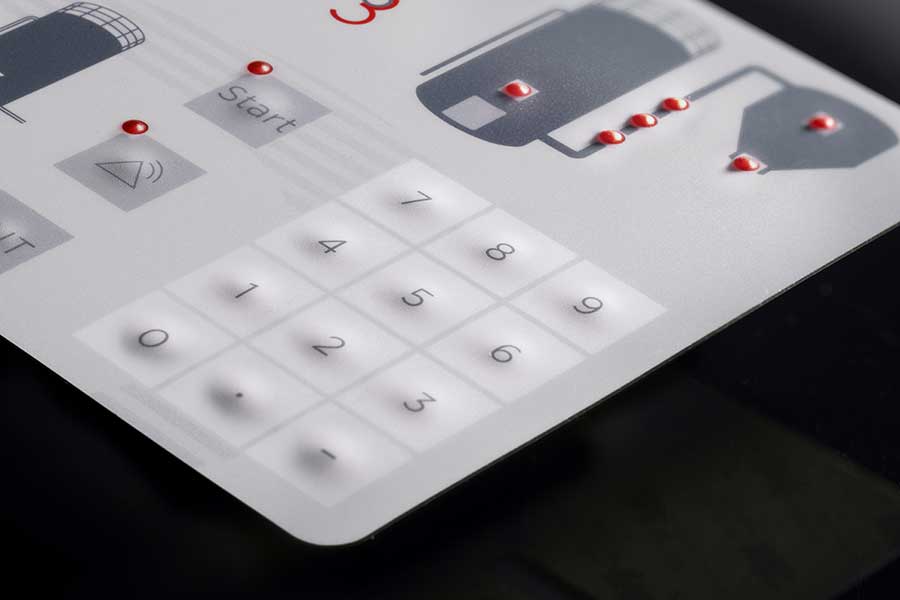Membrane Switches in the Aviation Technology: Major Applications and Benefits
Membrane Layer Switch Over Innovation: The Key to Reputable and Cost-Effective User Interfaces
Membrane layer button modern technology has actually arised as a crucial component in the design of user interfaces, offering both reliability and cost-effectiveness throughout a diverse range of applications. Its robust building guarantees resistance to ecological challenges, while the flexibility in layout permits for customized solutions that meet specific sector requirements. As we check out the multifaceted advantages of membrane buttons, their possibility for technology increases questions concerning future applications and evolving patterns. What does the next phase hold for this modern technology in a progressively digital landscape?
Comprehending Membrane Switch Over Innovation
Membrane layer switch modern technology is a widely used user interface option in various digital devices, using a smooth blend of performance and design. This innovation incorporates multiple layers of products, normally including a visuals overlay, spacer layer, and a circuit layer. The visuals overlay displays the user interface aspects, while the spacer layer divides the circuit layer from the overlay up until a customer activates a switch.
When stress is put on the overlay, the circuit layer finishes the electric circuit, sending a signal to the gadget. This device enables various arrangements, including responsive comments and backlighting alternatives, enhancing user communication. Membrane buttons are normally made using resilient products such as polyester or polycarbonate, making certain longevity and resistance to ecological variables like dampness and dust.
The flexibility of membrane changes allows their application in varied industries, including medical devices, consumer electronics, and industrial controls. Their portable style enables assimilation right into space-constrained settings, giving an efficient customer interface without compromising aesthetic appeal. Comprehending the ins and outs of membrane layer button innovation is essential for producers and designers seeking to create dependable and effective human-machine interfaces.
Secret Benefits of Membrane Buttons
While numerous user interface options exist, membrane layer switches over deal unique advantages that make them a preferred selection in countless applications. Among the key advantages is their longevity; membrane layer switches are designed to endure extreme environmental conditions, consisting of moisture, dirt, and temperature fluctuations, ensuring lasting performance. This strength dramatically lowers the need for constant replacements, thereby decreasing general upkeep prices.

In addition, membrane buttons are light-weight and compact, making them suitable for applications where room is limited. Their low-profile style adds to a streamlined look without compromising functionality.
Cost-effectiveness is additionally a notable advantage, as the manufacturing process for membrane changes often tends to be more economical contrasted to traditional mechanical switches. This affordability, combined with their reliability and simplicity of installation, positions membrane switches as a useful service for a large range of sectors looking for reliable and reliable customer interfaces.
Applications Throughout Different Industries
Exactly how do membrane switches adapt to the varied demands of different markets? Membrane button modern technology is significantly acknowledged for its versatility, making it appropriate for a large variety of applications throughout several markets. In the medical field, membrane layer buttons are made use of in analysis devices and client monitoring tools, where their resilience and ease of cleansing are important for preserving hygiene criteria. The auto market employs these buttons in control panels official statement and control board, using a streamlined visual while making sure easy to use procedure.
In customer electronic devices, membrane layer buttons supply a compact option for remote controls and home devices, improving customer experience through instinctive design. In addition, the commercial market leverages membrane switches for equipment control panels, gaining from their resistance to harsh atmospheres, such as moisture and dust.
Army and aerospace applications also use membrane layer switches for their dependability and capacity to endure severe conditions, making sure functional efficiency in essential situations. Moreover, the food and beverage market takes on these buttons for automated systems, where sanitation and simplicity of procedure are extremely important. Ultimately, membrane layer buttons are tailored to satisfy the one-of-a-kind demands of each industry, showing their crucial role in contemporary technology interfaces
Layout and Modification Options

In the world of membrane button technology, style and modification alternatives play a pivotal role in improving performance and user interaction. These switches can be customized to fulfill specific operational demands and aesthetic preferences, making them versatile components in numerous applications.
Among the main personalization choices is the design of the switch itself, which can be developed to accommodate unique customer interfaces and ergonomic factors to consider. By readjusting the form, size, and plan of buttons, manufacturers can develop user-friendly styles that assist in simplicity of use. In addition, the unification of various colors and graphic overlays enables branding and improved presence, ensuring that customers can quickly determine functions.
Furthermore, membrane switches can be crafted with different tactile feedback systems, such as elevated switches or distinct clicks, to enhance the individual experience. Different products can likewise be selected for durability and ecological resistance, dealing with elements such as moisture, temperature level changes, and chemical direct exposure.
Eventually, the extensive style and modification alternatives offered in membrane layer switch technology empower services to produce tailored remedies that not only satisfy practical requirements yet additionally straighten with their branding and operational needs.

Future Fads in Membrane Buttons
As membrane button modern technology proceeds to evolve, future trends are significantly concentrated on enhancing customer experience and incorporating advanced capabilities. One substantial fad is official statement the assimilation of touch-sensitive and capacitive innovations right into conventional membrane layer switches. This advancement read more permits more instinctive customer interfaces, providing tactile feedback while preserving a sleek design.
One more emerging pattern is the usage of eco friendly products, driven by the growing need for lasting production techniques. Makers are looking for to decrease their carbon footprint by utilizing recyclable substratums and low-impact inks, straightening with worldwide sustainability goals.
Furthermore, the rise of the Web of Things (IoT) is motivating the incorporation of clever functions into membrane layer switches. Improved connectivity choices will enable devices to interact with each other, permitting for seamless combination right into wider systems.
In addition, improvements in printing innovations, such as electronic printing, are enabling greater layout adaptability and modification. This allows producers to generate elaborate layouts and vivid colors cost-effectively.

Verdict
In conclusion, membrane layer button technology stands for a crucial advancement in customer interface layout, offering considerable benefits in longevity, modification, and cost-effectiveness. As developments proceed to emerge, especially in touch-sensitive user interfaces and lasting materials, the possibility for membrane switches to boost individual experience and functionality stays encouraging.